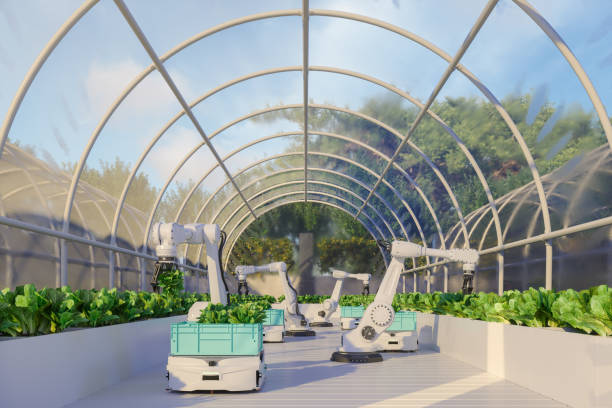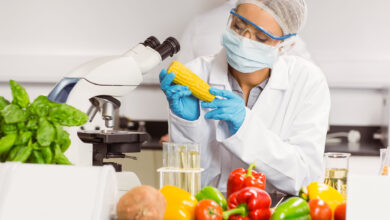
As technology continues to advance at an unprecedented rate, it is no surprise that it has also made its way into the agricultural sector. Today, modern technology (Innovative Farming) has revolutionized the way we approach agriculture, leading to increased efficiency, productivity, and sustainability. In this blog post, we will explore the role of modern technology in agricultural development and how it is shaping the future of farming. From precision farming to vertical farming, we will delve into the world of innovative farming and its potential to transform the way we produce food.
Understanding the Evolution of Agriculture with Technology (Innovative Farming)
As technology continues to advance at an unprecedented rate, it is no surprise that it has also made its way into the agricultural sector. Today, modern technology has revolutionized the way we approach agriculture, leading to increased efficiency, productivity, and sustainability.
The evolution of agriculture with technology (Innovative farming) can be traced back to the development of machinery in the 19th century. The introduction of machines such as tractors, combine harvesters, and seed drills transformed the industry, making it less labor-intensive and more productive. This allowed farmers to cultivate larger areas of land, leading to higher crop yields.
However, it wasn’t until the 20th century that technology truly began to shape the future of farming. The advent of electricity and the mechanization of various farming processes further enhanced productivity. Farmers were able to utilize machinery powered by electricity, such as milking machines and automated feeders, which not only reduced labor requirements but also improved the quality of the products.
In recent years, advancements in digital technology and connectivity have opened up new possibilities for the agricultural sector. The rise of precision farming has enabled farmers to gather and analyze data about their fields in real-time. By using sensors, drones, and satellite imagery, farmers can monitor soil moisture levels, nutrient content, and even pest infestations, allowing them to make data-driven decisions regarding irrigation, fertilization, and pest control.
Another groundbreaking technology that has reshaped farming practices is vertical farming. With the increasing demand for food and limited arable land, vertical farming offers a solution by utilizing indoor environments to grow crops in stacked layers. This approach minimizes the need for land and reduces water consumption while maximizing productivity.
Overall, the evolution of agriculture with technology has been a game-changer. From the development of machinery to the rise of precision farming and vertical farming, technology has transformed the way we grow food. With each innovation, the industry becomes more efficient, sustainable, and capable of feeding a growing population. The future of farming is undoubtedly tech-driven, and we can expect even more exciting developments in the years to come.

Modern Technology Innovative Farming and Reshaping Practices
As technology continues to advance, the agricultural sector is not being left behind. Modern technology has brought about significant changes in farming practices, revolutionizing the way we produce food. These technological innovations are reshaping farming practices, leading to increased efficiency, productivity, and sustainability.
One of the key technological advancements (Innovative farming) in agriculture is precision farming. With the help of sensors, drones, and satellite imagery, farmers can gather real-time data about their fields. This data allows them to monitor soil moisture levels, nutrient content, and even identify pest infestations. By using this information, farmers can make informed decisions regarding irrigation, fertilization, and pest control. This not only optimizes resource utilization but also reduces the use of chemicals, making farming more sustainable.
Another game-changing technology in farming is vertical farming. With limited arable land and the growing demand for food, vertical farming offers a solution. By utilizing indoor environments and stacking layers, crops can be grown vertically. This approach minimizes the need for land, reduces water consumption, and maximizes productivity. Vertical farming also allows for year-round cultivation, unaffected by weather conditions, providing a consistent supply of fresh produce.
Additionally, the integration of automation and robotics in agriculture is transforming farming practices. Autonomous vehicles, robotic milkers, and automated harvesting systems are being used to streamline tasks and reduce labor requirements. These technologies not only increase efficiency but also reduce costs and improve the quality of products.
Overall, modern technology innovations are reshaping farming practices in ways that were unimaginable in the past. Precision farming, vertical farming, and automation are just a few examples of how technology is improving efficiency, productivity, and sustainability in agriculture. The future of farming is indeed tech-driven, and we can expect even more exciting developments in the years to come.

How These Technological Advancements (Innovative Farming) Benefit Agricultural Development
The technological advancements in agriculture have had a profound impact on the development of the industry. These advancements have brought numerous benefits to agricultural development, leading to increased efficiency, productivity, and sustainability.
One of the key benefits of these technological advancements (Innovative farming) is improved resource management. With the help of precision farming technologies, farmers can gather real-time data about their fields and make informed decisions regarding irrigation, fertilization, and pest control. This optimization of resources not only reduces waste but also saves farmers time and money. Additionally, precision farming allows for targeted application of inputs, such as water and fertilizers, which minimizes environmental impact and improves sustainability.
Another significant benefit is the ability to produce more food in less space. Vertical farming, for example, allows for the cultivation of crops in stacked layers in indoor environments. This approach maximizes productivity while minimizing the need for land. Vertical farming also offers the advantage of year-round cultivation, unaffected by weather conditions, which ensures a consistent supply of fresh produce.
Furthermore, these technological advancements are helping farmers overcome challenges such as labor shortages and climate change. The integration of automation and robotics in agriculture streamlines tasks and reduces the reliance on manual labor. This not only increases efficiency but also allows farmers to focus on more specialized and strategic aspects of farming. Additionally, the use of precision farming technologies can help mitigate the impact of climate change by providing farmers with real-time data and insights to adapt their practices accordingly.
Overall, these technological advancements benefit agricultural development by improving resource management, increasing productivity, and promoting sustainability. As the industry continues to embrace innovation, we can expect even more exciting developments that will further transform the way we produce food.

Real-world Examples of Tech-Driven Farming Success
Technology has undeniably revolutionized the agricultural sector, and real-world examples of its success can be seen across the globe. One notable example is the use of precision farming techniques in the United States. Farmers in states like Iowa and Kansas have embraced technology to improve their yield and reduce input costs. By using sensors, drones, and satellite imagery, they are able to monitor soil moisture levels, nutrient content, and pest infestations in real-time. This allows them to make data-driven decisions regarding irrigation, fertilization, and pest control, resulting in higher crop yields and reduced environmental impact.
Another remarkable example of tech-driven farming success can be found in the Netherlands, where vertical farming has gained popularity. With limited arable land, Dutch farmers have turned to vertical farming to maximize productivity. By growing crops in stacked layers indoors, they are able to optimize space utilization and reduce water consumption. Vertical farming also offers the advantage of year-round cultivation, unaffected by weather conditions, ensuring a consistent supply of fresh produce.
In Australia, the use of automation and robotics has transformed farming practices. Robotic milkers and automated harvesting systems have improved efficiency and reduced labor requirements. This allows farmers to focus on more specialized tasks and increases the overall productivity of their operations. Additionally, Australian farmers have adopted precision farming techniques to mitigate the impact of climate change. Real-time data and insights enable them to adapt their practices and ensure the sustainable production of food.
These real-world examples of tech-driven farming success demonstrate the transformative power of technology in agriculture. From precision farming in the United States to vertical farming in the Netherlands and the integration of automation and robotics in Australia, technology is driving efficiency, productivity, and sustainability in the industry. These success stories serve as inspiration for farmers worldwide to embrace innovation and harness the potential of technology to shape the future of farming.

Overcoming Challenges and Limitations in Technology-driven, Innovative Farming
As with any technological advancement, there are always challenges and limitations to consider when it comes to technology-driven farming. While modern technology has brought about significant improvements in agriculture, it is important to acknowledge and address these challenges in order to fully harness the potential of these innovations.
One of the main challenges in technology-driven farming is the initial cost of implementing these technologies. The equipment, sensors, and software required for precision farming or vertical farming can be quite expensive, making it a barrier for small-scale farmers or those with limited financial resources. However, as technology continues to advance and become more accessible, the cost of these innovations is expected to decrease, making them more accessible to a wider range of farmers.
Another challenge is the digital divide that exists in rural areas. Access to high-speed internet and reliable connectivity is essential for the successful implementation of technology-driven farming practices. However, many rural areas still lack the necessary infrastructure, making it difficult for farmers in these regions to fully adopt these technologies. Governments and organizations need to invest in improving rural connectivity to bridge this gap and ensure equal opportunities for all farmers.
There is also a learning curve associated with adopting new technologies. Farmers need to be trained on how to effectively use and interpret the data collected from sensors and drones, or how to operate and maintain automated systems. Education and training programs should be provided to farmers to equip them with the necessary skills and knowledge to maximize the benefits of technology-driven farming.
Farmers are collecting and sharing large amounts of data about their fields, which can be sensitive information. Ensuring that this data is securely stored and protected from unauthorized access is crucial to maintain trust in these technologies.
Lastly, there is a need for ongoing research and development to continuously improve these technologies. As the agricultural industry evolves, new challenges and limitations may arise that require innovative solutions. Continued investment in research and development will be key to overcoming these challenges and pushing the boundaries of what is possible in technology-driven farming.
By acknowledging and addressing these challenges, we can work towards a future where technology-driven farming is accessible, sustainable, and beneficial for all farmers. Overcoming these limitations will allow us to fully harness the potential of these innovations and pave the way for a more efficient and sustainable agricultural industry.

Looking Forward: The Future of Innovative Farming and Technological Innovations
As we reflect on the significant advancements that technology has brought to the agricultural sector, it is clear that the future of farming is filled with even more exciting possibilities. With each passing year, technology continues to evolve and improve, and its impact on agriculture will undoubtedly shape the future of food production.
One area that holds great promise is the further integration of artificial intelligence and machine learning into farming practices. Imagine a future where algorithms can analyze vast amounts of data collected from sensors and drones, providing farmers with real-time insights and predictions. This level of precision and predictive capability could revolutionize how we make decisions about irrigation, fertilization, and pest control. By harnessing the power of AI, farmers will be able to optimize their resource usage and increase efficiency even further.
Another area of interest is the development of sustainable farming practices that can address the pressing environmental challenges we face. From climate change to soil degradation, these issues require innovative solutions. Technology can play a crucial role in developing and implementing sustainable farming practices, such as regenerative agriculture, where farmers focus on soil health and biodiversity. By utilizing precision farming techniques and innovative tools, farmers can improve soil quality, reduce greenhouse gas emissions, and conserve water resources.
Furthermore, advancements in biotechnology and genetic engineering hold tremendous potential for enhancing crop yields and developing plants that are more resistant to diseases and pests. Through genetic modification, we can create crops that require fewer pesticides and fertilizers, reducing environmental impact. These advancements can also lead to the development of drought-tolerant and disease-resistant crops, ensuring food security in regions that are prone to these challenges.
Looking forward, technology will continue to shape the future of farming in unimaginable ways. The possibilities are vast, and the potential for improving efficiency, sustainability, and productivity in agriculture is immense. As we navigate the challenges ahead, we must embrace innovation, invest in research and development, and foster collaboration between farmers, scientists, and technology experts. Together, we can build a future where technology-driven farming ensures a sustainable and thriving agricultural industry for generations to come.





I liked up to you’ll obtain carried out proper here. The comic strip is attractive, your authored material stylish. however, you command get got an edginess over that you want be delivering the following. sick indisputably come further earlier once more since precisely the similar just about very steadily within case you shield this increase.
I love studying and I believe this website got some truly utilitarian stuff on it! .
Hi, I think your site might be having browser compatibility issues. When I look at your website in Opera, it looks fine but when opening in Internet Explorer, it has some overlapping. I just wanted to give you a quick heads up! Other then that, fantastic blog!
Great – I should definitely pronounce, impressed with your website. I had no trouble navigating through all the tabs as well as related info ended up being truly easy to do to access. I recently found what I hoped for before you know it in the least. Reasonably unusual. Is likely to appreciate it for those who add forums or something, web site theme . a tones way for your client to communicate. Excellent task.
Tonic Greens: An Overview. Introducing Tonic Greens, an innovative immune support supplement
Thank you for the auspicious writeup. It in fact was a amusement account it. Look advanced to more added agreeable from you! By the way, how can we communicate?
Some really excellent info , Gladiolus I detected this. “Life is divided into the horrible and the miserable.” by Woody Allen.
I have been absent for a while, but now I remember why I used to love this website. Thank you, I will try and check back more often. How frequently you update your website?
What is Aizen Power? Aizen Power is an all-natural supplement to improve overall male health.
I was suggested this web site by my cousin. I’m not sure whether this post is written by him as nobody else know such detailed about my difficulty. You are wonderful! Thanks!
Wonderful work! This is the type of information that should be shared across the net. Shame on the search engines for now not positioning this submit higher! Come on over and visit my site . Thank you =)